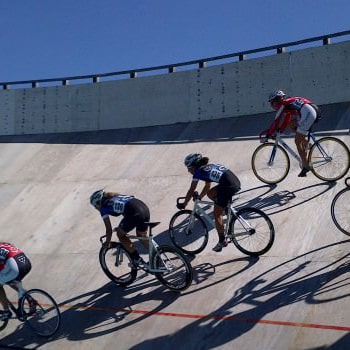Track

Track racing takes place on a banked velodrome 200-400 metres in circumference. It is particularly thrilling racing for both riders and spectators alike, and demands speed, concentration, skill, and strategy. A simple bicycle with no brakes and a fixed (non-coasting) gear is used.
Information
-
BC Velodromes
BC is home to two velodromes: the Burnaby Velodrome (one of only three indoor velodromes in Canada, and the only on in the Pacific Northwest), and the WestShore Velodrome.
The Burnaby Velodrome is located at 7564 Barnet Highway, Burnaby. For more information, visit the Burnaby Velodrome Club website.
The WestShore Velodrome is located at the Juan De Fuca Recreation Centre in Colwood, just outside of Victoria, BC. For more information, visit the Greater Victoria Velodrome Association website.
-
Track Events
Sprint
In the Sprint, two to four competitors cover 1000 metres. This race demands more tactical skill than any other bicycle race – riders jockey for position as they try to outwit each other before the final dash to the line. The final metres of a match sprint are said to be the most intense in cycling.
Olympic Sprint
In the Olympic Sprint, two teams of three riders start on opposite sides of the track. After the start, the first rider of each team leads the team around the track, pulling off at the end of the first lap and allowing the second rider to lead. At the end of the second lap, this rider pulls off and the third rider completes the final lap on their own. The winning team is the one with the fastest finishing time. This event relies heavily on careful team selection and planning. It requires both the acceleration of a sprinter and the power of a kilo rider.
Points Race
In the points race, riders start together and sprint against each other on specified laps throughout the race. Depending on their placing after these sprints, riders earn points. Unless a rider laps the field, the winner is the one that accumulates the most points.
Individual Pursuit
In the individual pursuit, two riders start, from a standing start, at opposite sides of the track. The winner is the first rider to cover the specified distance or to catch the other rider. Distances vary from 2 km to 4 km.
Team Pursuit
The rules of the team pursuit are the same as those of the individual pursuit–except that teams of four riders compete against each other. The time for the team is based on the team’s third finisher.
Time Trial
In the time trial, an individual cyclist races alone against the clock from a standing start. A time trial is either 1 km or 500m, and requires a maximum effort of 60 to 90 seconds. A time trial is always ridden as a straight final. The rider with the fastest time wins.
-
Categories and Upgrades
In BC, there are 5 different ability category (cat) levels for male and female road riders. Most races offer all of these categories, though some may be combined together for the purposes of racing.
- Cat. 1: Professional riders, who are members of National, Continental, or Professional teams
- Cat. 2: Highly skilled amateur riders
- Cat. 3: Intermediate level amateur riders
- Cat. 4: Novice level amateur riders
Provincial License holders do not have an ability category, and therefore can’t upgrade, as they either race in a Novice category a Provincial and Regional races.
Riders without a UCI license in the last 5 years must register for Cat 4; otherwise, they must register with the category that they had on their last UCI license, unless they are applying for an upgrade. Riders may apply to upgrade to the next highest ability level when they register for their license, or part way through the season. However, they cannot downgrade in the same season once you have upgraded. Riders must have held a UCI license in the last season to be eligible for an upgrade.
